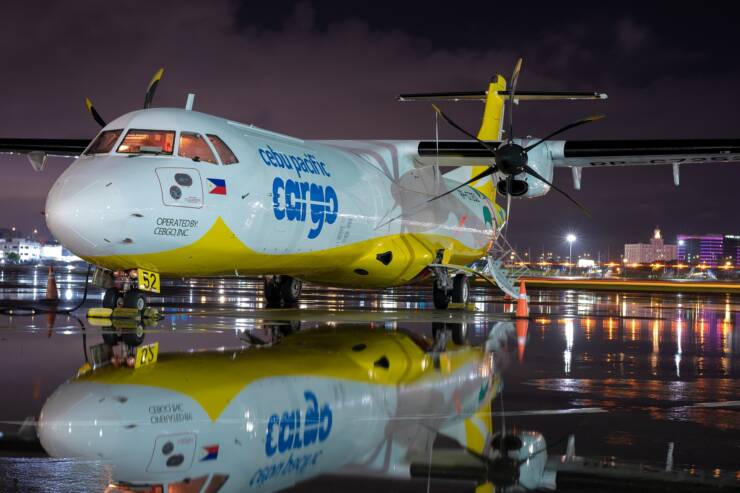
Manila. Cebu Pacific Air has been using its Pratt & Whitney Canada-powered ATR 72-500 freighter to transport medical supplies and other vital goods to help in Philippines’s COVID-19 relief effort.
Some passenger aircraft are grounded due to the pandemic, but Cebu Pacific deputy chief finance officer, Mark Cezar, says having the dedicated freighter means essential cargo can still be transported at reasonable cost.
“During the pandemic, Cebu Pacific has been able to fly humanitarian goods such as medical supplies across the Philippines, free-of-charge,” he says. The freighters have been used to serve government and non-government organizations in addition to businesses, says Cezar.
Cebu Pacific started replacing its ATR 72-500 passenger aircraft in 2016 with new ATR 72-600s, but rather than phase-out all the-500s, it decided to convert two of the aircraft to freighters. The first ATR converted freighter was delivered last year, while the second is expected to arrive within this year’s fourth quarter.
The ATR 72-500 and ATR 72-600 are both powered by the Pratt & Whitney Canada’s (P&WC) PW127 engine.
Cezar says: “The PW127 combines excellent take-off capabilities on the ATR with good fuel burn and low maintenance costs.”
Cebu Pacific’s PW127s are on P&WC’s Event Cost PlanTM (ECPTM), he says.
The P&WC ECP is a pay-at-the-event Fleet Management Program (FMPTM) maintenance plan that allows operators to pay an amount equal to a predetermined hourly rate at each maintenance visit for the coverage selected.
Operators like this plan because it is a comprehensive and flexible solution.
Cebu Pacific operates a large P&WC PW127 fleet because it needs an aircraft like the ATR which has short take-off and landing (STOL) capability. “The PW127 is ideal for STOL aircraft, because it is a light-weight engine and it allows the aircraft to have a slow approach when coming in to land, which is what you want when accessing short runways and airstrips.”
Cebu Pacific’s Cezar adds: “Having a STOL aircraft in our fleet allows us versatility in where we can fly. Only about 30% of the airports in the Philippines can accommodate a jet aircraft, and having the capability to serve smaller airports allows us to fly to more routes”.
Cebu Pacific decided to add dedicated ATR freighters, because it had a growing cargo business and found that belly-hold space on passenger aircraft was insufficient.
“It was just not enough. Passenger flights prioritize baggage, leaving limited space for cargo, so the space that can be allocated for cargo tended to vary,” says Cezar.
Cebu Pacific’s move into dedicated cargo operations also aligned to the move by the airline’s parent company, J.G. Summit Holdings, into e-commerce. J.G. Summit owns shopping centers, but cas see online shopping is a trend that is only going to grow bigger. J.G Summit has tapped the growth of online shopping by investing in e-commerce sites such as Shopee.
“Due to the strict quarantine restrictions in the Philippines, online shopping has flourished,” says Cezar. “In the past, it was a slow burn for online shopping, given the penchant of Filipinos to go to the malls. Having the capability to fly all-cargo and freighter services allows online shopping platforms and merchants to ship goods much faster and effectively meet customer demands and expectations. Speedy logistics also enables transporting to hubs in bulk, allowing for more competitive pricing and even deals, such as free shipping,” he adds.
Cebu Pacific’s dedicated freighter service has also helped Philippine exporters, especially those based in remote parts of the country.
Cezar says: “Our wide domestic network enables traders and exporters to bring in fresh products from various points in the Philippines, consolidate these [in Manila] and send to key export markets. For example, fresh fruits, high-value vegetables, and even live seafood can easily be flown from the provinces, then onwards to destinations across Asia, and even the Middle East.”
The P&WC-powered ATR 72-500 freighter can carry UDL containers, the standard size container used by the global air freight industry. The UDL containers are transferred from ATR freighters arriving in Manila to Cebu Pacific’s widebody aircraft for export.
Cezar says: “In an archipelago like the Philippines, having multiple points of connectivity and modalities of transportation is integral to economic development. Steady and reliable logistics is critical to move goods and people – whether for trade, commerce or tourism.”
“Having robust air connectivity is fundamental in driving growth in the economy down to the grass roots level,” he adds.
Cebu Pacific currently flies to 30 domestic destinations from its Manila and Cebu hubs, on top of five (5) international destinations namely Dubai, Hong Kong, Nagoya, Seoul, and Singapore.
Cebu Pacific has been rated 7/7 stars by airlineratings.com for its COVID-19 compliance as it continues to implement a multi-layered approach to safety, in accordance with global aviation standards. These include contactless procedures, thorough cleaning and disinfection protocols for all aircraft and facilities, mandatory wearing of masks and face shields for both passengers and crew, as well as Antigen testing for its frontliners before duty. Its aircraft are also equipped with hospital-grade HEPA filters with 99.99% efficacy, keeping viruses at bay.








